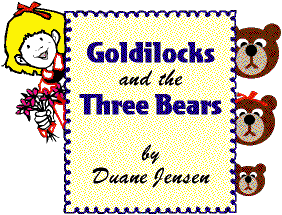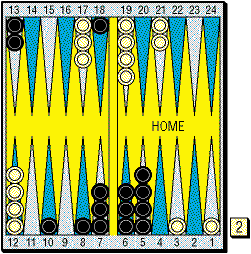
It's a snippet from the 1990s version of "Goldilocks and the Three Bears" if the classic fairy tale had been written today. You remember the story: a young girl stumbles into the home of the three bears. She eats the porridge, breaks a chair and invades the bedroom. Goldilocks was nothing more than a glorified delinquent.
The common thread which ran through the story of her rampage was that she always had three choices. Whose porridge to eat? Whose chair to sit in? Whose bed to sleep in: Papa Bear's, Mama Bear's, or Baby Bear's?
I've noticed that in many backgammon positions, I can usually distill the checker plays down to three options. Let's open the storybook and look at our example. You will have three choices just as Goldilocks had:

7 point match. Black leads
White, 5 to 3.
Black to play 5-2.
Black has three good options for his 5-2. He can play:
A. 8/1, hitting two blots (the Papa Bear play)
B. 8/3, 5/3, pointing on the blot (the Mama Bear play)
C. 18/13, 10/8, playing safe (the Baby Bear play)
Which play is best? As usual, a careful player must study all the parameters: the match score, cube ownership, height, weight and humidity. Play A must be considered because it hits two blots. This aggressive play often reaps a good harvest.
Play B leaves as many return shots (12) as A but has the advantage of building another inner point.
Play C makes a 4-prime leaving no blots for Black to hit.
None of the plays is "best" by default. In money play, B is probably the most profitable. In this situation, gammons are meaningless to Black making the conservative Baby Bear play the best choice.
Black should risk no more than is necessary. As Goldilocks did, choose the play that feels "just right." -- Duane Jensen


